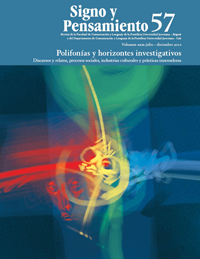Abstract
This article discusses the ways in which technological devices and computer screens are consumed and appropriated by young newcomers to Universidad Nacional de Rosario (unr), in Argentina. We acknowledge that the young are who most use and consume the new digital media and technological devices such as the different display screens (cell phones, TVs, and PCs) and who, furthermore, access them both naturally and selectively in order to consume other digital products available through these same screens. Herein, we present the first results of a survey carried out among UNRs newcomers to the Faculty of Political Sciences and International Relations in 2008.
Benzécri J. P. et al. (1976), L'Analyse des données, T.1 La Taxonomie T. 2 L'Analyse des correspon- dances, París, Dunod.
Carrier et al. (2006), “Los adolescentes y el celular” [en línea], disponible en: http://www.car- rieryasoc.com/images/documentos/Los%20 adolescentes%20y%20el%20celular%20-%20 Marzo%202006.pdf, recuperado: 14 de mayo de 2009.
Carlón, M. y Scolari, C. (eds.) (2009), El fin de los medios masivos, Buenos Aires, La Crujía Ediciones.
Proyecto de Investigación pid (2010), “Interfaces en pantallas. Una experiencia de investigación” (2010), Medios y Enteros [en línea], núm. 3, disponible en: http://www.mediosyenteros. org.ar/, recuperado 12 de abril de 2010
Lebart, L. et al. (1993), spad.T Integré® version 1.5 Système Portable pour l’Analyse des Donnés Textuelles, París, cisia.
Lebart, L. et al. (2000), Système spad, Versión 4.51, París, ®cisia-ceresta.
Lebart, L.; Morineau, A., y Piron, M. (1995), Statistique exploratoire multidimensionnelle, París, Dunod.
Lebart, L. y Salem, A. (1994), Statistique textuelle, Dunod, París.
Moscoloni, N. (2005), Las nubes de datos. Métodos para analizar la complejidad, Rosario, Editorial Universidad Nacional del Rosario.
Moscoloni, N. et al. (1995), “Análisis textual de opiniones de estudiantes de la unr”, en Bolasco, S.; Lebart, L., y Salem, A. (eds.), III Giornate Internazionali di Analisi Statistica dei Dati Testuali, vol. II, CNR.
Moscoloni, N. y Satriano, C. (2000), “Importancia del análisis textual como herramienta para el análisis del discurso. Cinta de Moebio”, Electronic Journal for Social Sciences Epistemology [en línea], Facultad de Ciencias Sociales,
Universidad de Chile, núm. 9, disponible en: http//www.moebio.uchile.cl/09/frames08. htm, recuperado: 12 de abril de 2010.
Mourduchowicz, R. (2003), El capital cultural de los jóvenes, Buenos Aires, Fondo de Cultura Económica.
— (2008), Los jóvenes y las pantallas, Buenos Aires, Gedisa.
This journal is registered under a Creative Commons Attribution 4.0 International Public License. Thus, this work may be reproduced, distributed, and publicly shared in digital format, as long as the names of the authors and Pontificia Universidad Javeriana are acknowledged. Others are allowed to quote, adapt, transform, auto-archive, republish, and create based on this material, for any purpose (even commercial ones), provided the authorship is duly acknowledged, a link to the original work is provided, and it is specified if changes have been made. Pontificia Universidad Javeriana does not hold the rights of published works and the authors are solely responsible for the contents of their works; they keep the moral, intellectual, privacy, and publicity rights.
Approving the intervention of the work (review, copy-editing, translation, layout) and the following outreach, are granted through an use license and not through an assignment of rights. This means the journal and Pontificia Universidad Javeriana cannot be held responsible for any ethical malpractice by the authors. As a consequence of the protection granted by the use license, the journal is not required to publish recantations or modify information already published, unless the errata stems from the editorial management process. Publishing contents in this journal does not generate royalties for contributors.


